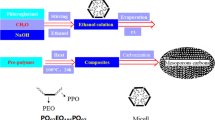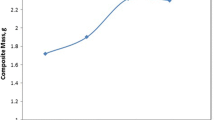Abstract
Mesoporous carbons with bimodal rod-like pore structures and tunable pore sizes from 3.66 to 5.42 nm were for the first time obtained by employing SBA-15 as templates and raffinose as carbon precursors. Small angle X-ray diffraction, transmission electron microscopy, scanning electron microscopy, N2 sorption analysis, and Raman spectroscopy were used to determine the textural properties of the resulting materials. Bimodal frameworks with mesopores (4–5 nm) as well as macropores (125–130 nm) were achieved. The mesoporous carbons lost its ordered structure from the templates due to mesostructural shrinkage and collapse of mesopores, which resulted in partial duplicate of the template and pore-widening effect (meso to macropores). With the increasing of carbonization temperature from 500, 700 to 900 °C, the textural parameters such as specific surface areas, pore volumes, and mean pore diameters all increased significantly. In the temperature range studied, higher carbonization temperature would generate much more abundant porosity. The ratio of I D to I G (I D/I G) indicated a rather low crystallinity with the varying of aging temperature and the carbonization temperatures. The advantage of the procedure was that no acid or other chemical catalysts were involved during the infiltration and carbon formation process.








Similar content being viewed by others
References
Li XT, Chen XH, Song HH (2009) J Mater Sci 44:4661. doi:10.1007/s10853-009-3714-2
Inomata K, Otake Y (2009) J Mater Sci 44:4200. doi:10.1007/s10853-009-3560-2
Yang HF, Yan Y, Liu Y, Zhang FQ, Zhang RY, Meng Y et al (2004) J Phys Chem B 108:17320
Shin Y, Fryxell GE (2008) Chem Mater 20:981
Lu AH, Spliethoff B, Schuth F (2008) Chem Mater 20:5314
Fulvio PF, Jaroniec M, Liang CD, Dai S (2008) J Phys Chem C 112:13126
Liu YR (2009) J Mater Sci 44:3600. doi:10.1007/s10853-009-3487-7
Mirzaeian M, Hall PJ (2009) J Mater Sci 44:2705. doi:10.1007/s10853-009-3355-5
Arcos D, Lopez-Noriega A, Ruiz-Hernandez E, Terasaki O, Vallet-Regi M (2009) Chem Mater 21(6):1000
Vallet-Regi M, Balas F, Arcos D (2007) Angew Chem Int Ed 46:7548
Balas F, Manzano M, Horcajada P, Vallet-Regi M (2006) J Am Chem Soc 128:8116
Slowing II, Trewyn BG, Lin VSY (2007) J Am Chem Soc 129:8845
Torney F, Trewyn BG, Lin VSY, Wang K (2007) Nat Nanotechnol 2:295
Ryoo R, Joo SH, Jun S (1999) J Phys Chem B 103:7743
Ying JY, Mehnert C, Wong MS (1999) Angew Chem Int Ed 38(1):56
Lu AH, Schuth F (2006) Adv Mater 18:1793
Lu AH, Schmidt W, Spliethoff B, Schuth F (2003) Adv Mater 15(19):1602
Kim TW, Park IS, Ryoo R (2003) Angew Chem 115:4511
Lee HI, Kim JH, You DJ, Lee JE, Kim JM, Ahn WS et al (2008) Adv Mater 20:757
Vinu A (2008) Adv Funct Mater 18:816
Jiang XG, Brinker CJ (2006) J Am Chem Soc 128:3451
Yuan SL, Zhang XQ, Chan KY (2009) Langmuir 25:2034
Kadib AE, Hesemann P, Molvinger K, Brandner J, Biolley C, Gaveau P et al (2009) J Am Chem Soc 131:2882
Armandi M, Bonelli B, Otero Arean C, Garrone E (2008) Microporous Mesoporous Mater 112:411
Armandi M, Bonelli B, Karaindrou EI, Otero Arean C, Garrone E (2008) Catal Today 138:244
Roggenbuck J, Tiemann M (2005) J Am Chem Soc 127:1096
Lu AH, Schmidt W, Spliethoff B, Schuth F (2004) Chem Eur J 10:6085
Acknowledgements
The authors acknowledge the financial support from the National Science Foundation of China (No.50802017), the Medical Science Research Fund of GuangDong Province (No.B2009118) and the Teaching Staff Construction Fund of Guangdong Pharmaceutical University.
Author information
Authors and Affiliations
Corresponding author
Rights and permissions
About this article
Cite this article
Wang, X., Tian, Y., Song, G. et al. Synthesis and characterization of bimodal rod-like mesoporous carbons from raffinose by SBA-15 templates. J Mater Sci 45, 2958–2966 (2010). https://doi.org/10.1007/s10853-010-4292-z
Received:
Accepted:
Published:
Issue Date:
DOI: https://doi.org/10.1007/s10853-010-4292-z




